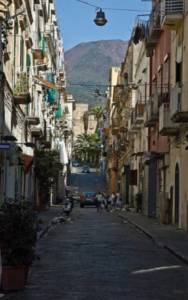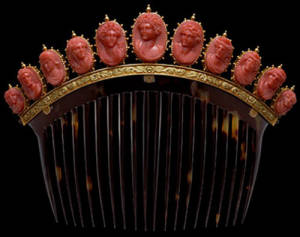Italian Cameos from Torre Del Greco
The harvesting of coral in the coastal city of Torre del Greco dates back to at least the beginning of the 15th century. It was not until the 17th century though, that coral harvesting become the main town activity. The harvest was entirely sold to the Jewish community living in Leighorn and Genoa. But turning “red gold” into jewelry didn’t begin until 1805, when the King of Naples, Ferdinando IV, granted Paolo Bartolomeo Martin of Marseille, France, a 10-year monopoly on the manufacture of coral in Torre del Greco. At that moment an industry was born and “Torre del Greco” took off.
The inhabitants of Torre del Greco developed a technique using hand tools to engrave conch shells and hardened lava (lavic) to create cameos. The engravings, which have changed little over the years, are mainly relief sculptures, usually oval or round, that include portraits of women’s faces, mythological representations, flowers, animals, landscapes, and scenes of daily life in Torre del Greco. In 1878 a school was founded to ensure sufficient trained people were available to handle the increased demand. It is interesting to note that another hub in Europe dealing with cameos, and in particular gemstones and Agate objects blossomed in the same period in Germany: Idar-Oberstein.
History of Torre del Greco
The reference to a tower, may refer to a medieval lookout tower which once stood on the coast, but is no longer extant. The people are sometimes called Corallini because of the plentiful coral in the nearby sea, and because the city has been a major producer of Coral jewelry and Cameo brooches since the 19th Century. “Torre Del Greco” was a popular summer resort town for wealthy Italians beginning in the 19th Century and continuing into the early 20th Century. Many wealthy families and even Italian Nobility, built elaborate summer palaces on the outskirts of the town, among the most notable of these is the Palazzo Materazzo.
Torre Del Greco was known for it’s Cafe’s and Eateries during it’s heyday, particularly the “Gran Cafe Palumbo” a large Art Nouveaux style Cafe which supplied hungry tourists and locals with all manner of gelato, pastries, food, and Coffee and had an extensive outdoor pavilion. The famous Italian comedian Toto, was among those who made Torre Del Greco their annual summer retreat. The reason for Torre Del Greco’s popularity as a resort town, was it’s beaches and the bucolic setting of lush farmland and Vinyards, as well as the vicinity of Mt. Vesuvius.
Cameo and Coral Jewelry Industry in Torre del Greco
Today the city of rolling hills in the province of Naples and in the shadow of Mount Vesuvius is the hub of the coral and cameo jewelry world, with approximately 350 companies and 2,600 workers directly involved in turning coral into objects of beauty. About 75 percent of the city’s production is exported. Its largest markets are Japan, the United States, and Europe. Annual income from the trade is roughly $222 million.
Nearly all the companies that toil in this art form are family owned and very small. More than 60 percent operate with no more than three people. Most work independently, but in 1978 some of them organized into the Associazione Produttori Coralli Cammei e Materie Affini (National Association Coral Producers, Analogous Cameos and Materials, aka Assocoral). In September and October of 2006, this organization held a bicentennial celebration of the local coral and cameo industry with a museum exhibition, an international design competition, and a fashion show.
Casco Cameos: Wearable Portraits
Wearable Portraits carved in relief on materials like shell, lava and agate—were once known for their noble and dignified subjects: Roman emperors, queens and figures from Greek mythology. Now, designers are giving the once-demure art form a modern twist. Leading the charge is Amedeo Scognamiglio, whose Amedeo collection stems from his family’s long history of cameo making in Torre del Greco, Naples. Alongside more traditional offerings, monkeys, skulls and crossbones and jaunty cameo cuffs also make an appearance, each piece still handmade. Casco, a nearby factory run by another branch of the Scognamiglio family, has its own range of classic pieces and also makes skull cameos for a number of contemporary fashion designers.
Torre de Greco (Tower of Greeks) is a specialized center. The sector employs at least 1,000 people, with about 400 firms in the area, of various sizes, but alongside them there is an indefinite number of microlabs which work for third parties for so-called business-to-collector.
The goldsmith’s art and the Torre del Greco can be said that it is big business with centuries of tradition behind it, known all over the world and with a question is fairly stable which allows the life of medium-large companies that the proliferation of small and very small laboratories. With regard to the processing of coral, Torre del Greco has a long tradition that dates back to 1500, fishing activities of the coral to get to work the same in1805, when King Ferdinand IV of Bourbon granted that the right to process Bartholomew of the Martyrs Cardinal coral.
They organized themselves well, around the figure of the Cardinal, many of the local craftsmen, giving rise to the Royal School of Coral. In the second half of the 800 also starts working cameo, due principally to the need for market diversification as they were beginning to feel the first of the raw material supply problems. In fact, until 1860-70, was worked exclusively on the Mediterranean red coral.
From the early years of the ‘900 has become increasingly important to the Pacific coral manufacturing (coming mostly from the Sea of Japan). The current production is smooth up to the coral carvings and sculptures. The creative imagination and perfect design make it very competitive in the world of coral Torre del Greco crafts. The Torre del Greco school is popular for its beautiful cameos of hard stone bas-relief work. The most commonly used material is the sardonic, Indian sea shell with a beautiful two-tone black and white, but there are also other materials: shells and tigrina carnelian, coral, lava rock, Turquoise paste and Chalcedony



